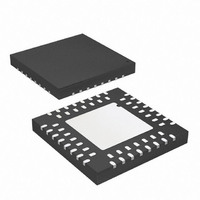ATMEGA169P-16MCH Atmel, ATMEGA169P-16MCH Datasheet - Page 150

ATMEGA169P-16MCH
Manufacturer Part Number
ATMEGA169P-16MCH
Description
MCU AVR 16KB FLASH 16MHZ 64-VQFN
Manufacturer
Atmel
Series
AVR® ATmegar
Datasheet
1.ATMEGA169PV-8AU.pdf
(395 pages)
Specifications of ATMEGA169P-16MCH
Core Processor
AVR
Core Size
8-Bit
Speed
16MHz
Connectivity
SPI, UART/USART, USI
Peripherals
Brown-out Detect/Reset, LCD, POR, PWM, WDT
Number Of I /o
54
Program Memory Size
16KB (8K x 16)
Program Memory Type
FLASH
Eeprom Size
512 x 8
Ram Size
1K x 8
Voltage - Supply (vcc/vdd)
2.7 V ~ 5.5 V
Data Converters
A/D 8x10b
Oscillator Type
Internal
Operating Temperature
-40°C ~ 85°C
Package / Case
64-VQFN Exposed Pad, 64-HVQFN, 64-SQFN, 64-DHVQFN
For Use With
ATSTK600 - DEV KIT FOR AVR/AVR32ATAVRBFLY - KIT EVALUATION AVR BUTTERFLYATSTK502 - MOD EXPANSION AVR STARTER 500ATSTK500 - PROGRAMMER AVR STARTER KIT
Lead Free Status / RoHS Status
Lead free / RoHS Compliant
- Current page: 150 of 395
- Download datasheet (9Mb)
17.8
17.8.1
8018P–AVR–08/10
Asynchronous operation of the Timer/Counter
Asynchronous Operation of Timer/Counter2
When Timer/Counter2 operates asynchronously, some considerations must be taken.
• Warning: When switching between asynchronous and synchronous clocking of
• The CPU main clock frequency must be more than four times the Oscillator frequency.
• When writing to one of the registers TCNT2, OCR2A, or TCCR2A, the value is transferred to a
• When entering Power-save or ADC Noise Reduction mode after having written to TCNT2,
• If Timer/Counter2 is used to wake the device up from Power-save or ADC Noise Reduction
• When the asynchronous operation is selected, the 32.768 kHz Oscillator for Timer/Counter2 is
Timer/Counter2, the Timer Registers TCNT2, OCR2A, and TCCR2A might be corrupted. A
safe procedure for switching clock source is:
temporary register, and latched after two positive edges on TOSC1. The user should not write
a new value before the contents of the temporary register have been transferred to its
destination. Each of the three mentioned registers have their individual temporary register,
which means that, for example, writing to TCNT2 does not disturb an OCR2A write in progress.
To detect that a transfer to the destination register has taken place, the Asynchronous Status
Register – ASSR has been implemented.
OCR2A, or TCCR2A, the user must wait until the written register has been updated if
Timer/Counter2 is used to wake up the device. Otherwise, the MCU will enter sleep mode
before the changes are effective. This is particularly important if the Output Compare2 interrupt
is used to wake up the device, since the Output Compare function is disabled during writing to
OCR2A or TCNT2. If the write cycle is not finished, and the MCU enters sleep mode before the
OCR2UB bit returns to zero, the device will never receive a compare match interrupt, and the
MCU will not wake up.
mode, precautions must be taken if the user wants to re-enter one of these modes: The
interrupt logic needs one TOSC1 cycle to be reset. If the time between wake-up and re-
entering sleep mode is less than one TOSC1 cycle, the interrupt will not occur, and the device
will fail to wake up. If the user is in doubt whether the time before re-entering Power-save or
ADC Noise Reduction mode is sufficient, the following algorithm can be used to ensure that
one TOSC1 cycle has elapsed:
always running, except in Power-down and Standby modes. After a Power-up Reset or wake-
up from Power-down or Standby mode, the user should be aware of the fact that this Oscillator
might take as long as one second to stabilize. The user is advised to wait for at least one
second before using Timer/Counter2 after power-up or wake-up from Power-down or Standby
mode. The contents of all Timer/Counter2 Registers must be considered lost after a wake-up
a. Disable the Timer/Counter2 interrupts by clearing OCIE2A and TOIE2.
b. Select clock source by setting AS2 as appropriate.
c. Write new values to TCNT2, OCR2A, and TCCR2A.
d. To switch to asynchronous operation: Wait for TCN2UB, OCR2UB, and TCR2UB.
e. Clear the Timer/Counter2 Interrupt Flags.
f.
a. Write a value to TCCR2A, TCNT2, or OCR2A.
b. Wait until the corresponding Update Busy Flag in ASSR returns to zero.
c. Enter Power-save or ADC Noise Reduction mode.
Enable interrupts, if needed.
ATmega169P
150
Related parts for ATMEGA169P-16MCH
Image
Part Number
Description
Manufacturer
Datasheet
Request
R

Part Number:
Description:
Manufacturer:
Atmel Corporation
Datasheet:

Part Number:
Description:
Manufacturer:
Atmel Corporation
Datasheet:

Part Number:
Description:
IC AVR MCU 16K 16MHZ IND 64-TQFP
Manufacturer:
Atmel
Datasheet:

Part Number:
Description:
IC AVR MCU 16K 16MHZ IND 64-QFN
Manufacturer:
Atmel
Datasheet:

Part Number:
Description:
MCU AVR 16KB FLASH 16MHZ 64TQFP
Manufacturer:
Atmel
Datasheet:

Part Number:
Description:
MCU AVR 16K ISP FLSH 16MHZ 64QFN
Manufacturer:
Atmel
Datasheet:

Part Number:
Description:
IC MCU AVR 16K 16MHZ IND 64QFN
Manufacturer:
Atmel
Datasheet:

Part Number:
Description:
8-bit Microcontrollers - MCU Microcontroller
Manufacturer:
Atmel

Part Number:
Description:
Atmega169p 8-bit Avr Microcontroller With 16k Bytes In-system Programmable Flash
Manufacturer:
ATMEL Corporation
Datasheet:

Part Number:
Description:
IC AVR MCU 16K 16MHZ IND TQFP
Manufacturer:
Atmel
Datasheet:

Part Number:
Description:
IC AVR MCU 16K 16MHZ IND 64-QFN
Manufacturer:
Atmel
Datasheet:











